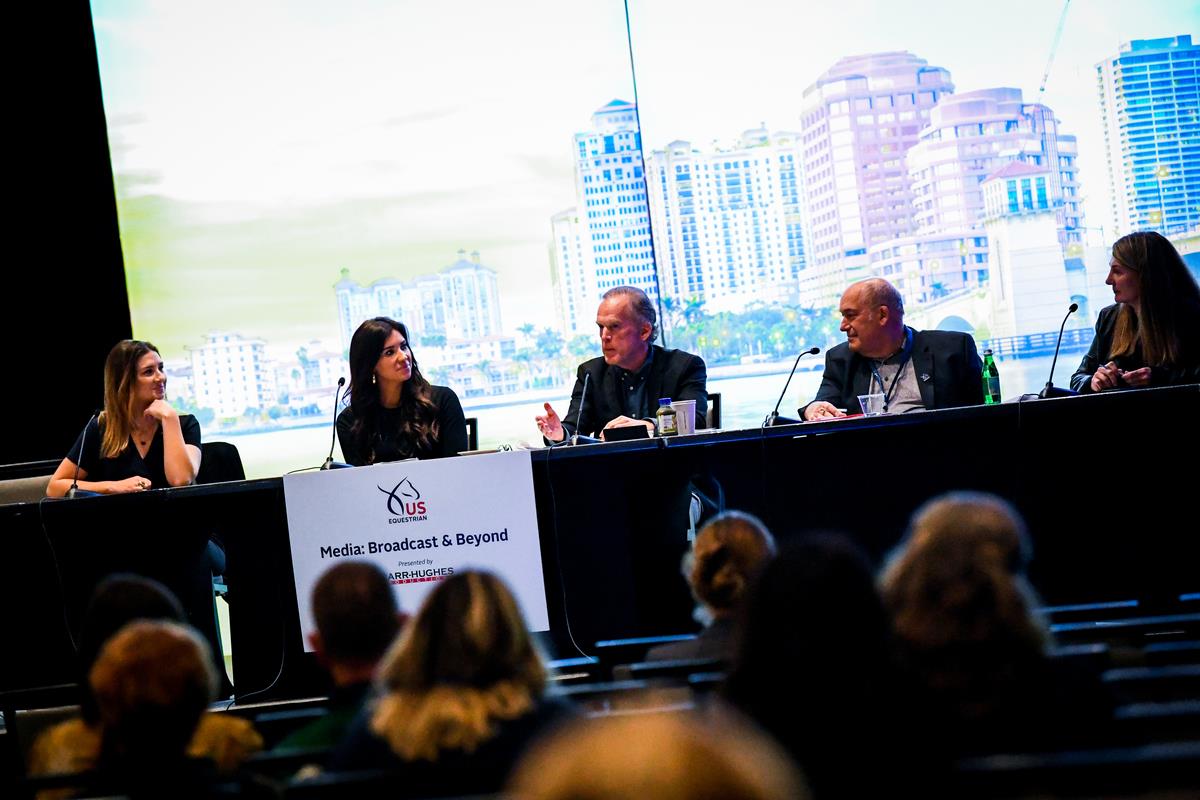A talented group of media experts made up the panel discussing the changing media landscape and how equestrian sport fits into the picture. Vicki Lowell, US Equestrian’s Chief Marketing and Content Officer, moderated the discussion between Rich Cronin, a media consultant for Ride TV; Andrea Evans, US Equestrian’s Director of Digital and Social Media Strategy; Bob Hughes, Carr-Hughes Productions' Executive Producer; and Taryn Young, founder of @warmbloodsandwine.

(US Equestrian)
The panelists shared some of the equestrian media victories that they have experienced in their work.
- Hughes noted that the NBC broadcast of the Land Rover Kentucky Three-Day Event presented by MARS EQUESTRIAN (LRK3DE) has aired since 1999 with strong viewership. He pointed out that focusing on the eventing competition allows viewers to get a taste of each of the Olympic equestrian disciplines.
“Our goal has always been to broaden the scope of the USEF by reaching a large number of viewers and people who aren’t familiar with the sport or know what it is, and hopefully bring in more people to the sport and the federation,” said Hughes.
- Cronin mentioned Ride TV’s successful show “PBR Ride to Glory,” which highlights the interesting characters competing on the Professional Bull Riders tour. He explained the show has broadened the audience of Ride TV.
“We want to have more and more great entertainment, so that includes sports, Western and English, but it also includes stories. The key is stories about great characters,” said Cronin. “My way of getting more people interested in equestrian sports is to get them to know more about the characters and the people behind them.”
- Young decided to start an equestrian lifestyle Instagram account in December 2018, using a curated, stylistic approach. She gained thousands of followers who found her adult-amateur lifestyle relevant to their own experiences.
“It has turned into a community. I get a lot of feedback from a lot of adult-amateurs,” said Young. “I am in dressage, so I think I am at the younger end of the spectrum, but a lot of people struggle with work-life-riding balance, so I think people saw me as being relatable.”
- Evans joined US Equestrian in 2015 and has grown the social media following to over 840,000 people with the help of a passionate and talented team. She believed that taking risks and trying new things with the social media platforms has largely been part of the team’s success.
“The evolution of the production quality of our live streams over the last few years has really helped our content significantly where we are able to bring our viewers and our members at US Equestrian the highest quality content that is available to us,” added Evans.
Brands see the importance of changing with the times and being innovative to be successful and to continue to grow. From sponsorship teams being pleased that they spent the money to sponsor an event to personal brands finding what works, the panelists were familiar with the need to be flexible and creative.
- Hughes explained that on-screen signage was electronically inserted into the field of play for each phase of the LRK3DE broadcast in 2019. He said it was a technical product with an additional cost, but it didn’t compromise the competition or the broadcast program.
“We are able to get the sponsor a little more bang for their buck,” said Hughes.
- At first, Young was reluctant to put her face in her social media posts, but she found that the posts with her and her horse or her dog performed the best with followers. She noted that creating a sense of community, including engaging with followers, is important to being successful on social media platforms.
“People want to relate to a person who is like them and who is going through the same hardships,” said Young. “Athletes who do put themselves out there have the greatest following.”
- Evans collaborated with the US Equestrian design team to create a façade on the USEF Network Instagram account as visual representations of live streams the USEF Network did in 2019. Looking ahead to 2020, she wants to explore Tik Tok, the rapidly growing social media platform, and social media software that could capitalize on US Equestrian’s content and influencers’ reach.
“We have to empower our athletes and our community to be posting the content because their reach collectively is going to be so much more than what we are able to reach from our platforms,” said Evans.
- Cronin noted that Ride TV makes pilot episodes of potential series and airs them as specials. He said the specials that do well with audiences then turn into series on the network.
“The audience will decide what goes to series,” said Cronin. “It is the kind of thing that we think will help to get more people interested in the sport.”
The panelists had great insights into the continuous development of media and how equestrian sport can stay relevant in 2020 and beyond. For more insights from the panel, watch the archived stream of the panel Media Broadcast & Beyond presented by Carr-Hughes Productions now at USEF Network.


